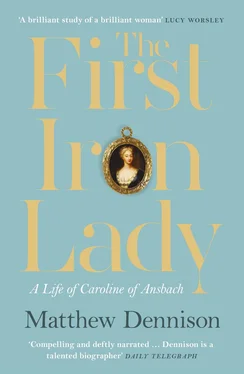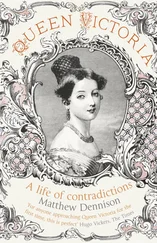Infidelity was a prerogative of princes. Sophia tolerated Countess von Platen, Figuelotte mostly overlooked Madame von Wartenburg; Ernest Augustus indicated to his daughter-in-law that she must make similar concessions. In 1690, George Louis had acquired the mistress to whom he would remain faithful for life, tall, thin, plain Melusine von der Schulenburg, whom his mother disparaged as a ‘malkin’, a picturesque noun applied equally to scarecrows and slatterns. 65Within three years Madame Schulenburg had two daughters, referred to as her nieces, and, like the elector John George IV in his affair with Billa von Neitschütz, George Louis all but lived with her. Sophia Dorothea’s retaliation had a tit-for-tat quality, but husband and wife inhabited a world in which men and women were not judged as equals, and women’s faithlessness, with its danger of pregnancy and illegitimacy, threatened the integrity of royal succession. ‘Does the young duchess not know that a woman’s honour consists of having commerce with no one but her husband, and that for a man it is not shameful to have mistresses but shameful indeed to be a cuckold?’ Liselotte asked rhetorically. 66
A predictably tight-lipped nineteenth-century verdict casts Königsmarck as a ‘handsome, wicked, worthless reprobate’; his sister judged him ‘an equal mixture of Mars and Adonis’. 67To Sophia Dorothea, the raffish Swedish mercenary provided an exhilarating contrast to George Louis, with his brusque neglect, eruptions of physical violence and, when it suited him, perfunctory love-making. In suggestive French, in letters written in code in invisible ink, Königsmarck wooed his princess. He called her his ‘divine beauty’, he signed his name in blood. He courted her lady-in-waiting, Eleonore von dem Knesebeck, who acted as go-between for the lovers, concealing Sophia Dorothea’s replies to his letters in hats and gloves and stitching his own letters into curtain linings safely out of sight. He also cultivated the good opinions of Sophia and Ernest Augustus. In 1692 Stepney reported Königsmarck directing ‘splendid ballets … all in maskeradings’ in the Leineschloss opera house. 68
‘Maskeradings’ on the electoral stage were an apt metaphor. Princess and count progressed from artless dalliance to desperate longing, fuelled in part by their shared talent for self-dramatisation. In their letters and dizzy assignations they slipped between the worlds of fairy tale and melodrama, their emotions heroic in intensity, in daring, in urgency. Königsmarck labelled himself ‘a poor butterfly burnt by the flame’; he confided to Sophia Dorothea a terrifying but prophetic dream in which his actions were punished by execution; he was exaggeratedly jealous of George Louis’s continuing conjugal rights and begged God to kill him if Sophia Dorothea failed him. 69Neither lover accepted responsibility for behaviour they knew to be perilous. But Sophia Dorothea’s posturing included a measure of genuine unhappiness.
That she crossed the Rubicon from flirtation to infatuation was plainly ill-advised. That she disdained discretion or concealment was still more injudicious. Sophia and Figuelotte were among those who counselled against the dangers of transgression. Determined to divorce George Louis and marry Königsmarck, she ignored their warnings. Unaware of the impossibility of her financial position, she fixated on the idea of elopement. ‘Let us love one another all our lives and find comfort in one another for all the unhappiness brought on us,’ she pleaded. 70
Four years after their first exchange of letters, desperate measures brought to an end the romance of Sophia Dorothea and her dashing Swede. On the eve of his departure for Dresden to take up a position as major general in the Saxon army, Königsmarck was murdered en route to his mistress’s apartments in the Leineschloss. Orders for his killing probably originated with Ernest Augustus or, on his behalf, Countess von Platen. A particularly gruesome version of events has a vengeful and incensed countess grinding his face beneath her high-heeled shoe. George Louis was absent on a visit to Figuelotte in Berlin. 71The deed itself, on 1 July 1694, was the work of a quartet of Hanoverian loyalists, including von Eltz and an architect called Nicolò Montalbano, who shortly received from Ernest Augustus an enormous one-off payment of 150,000 thalers. 72Königsmarck was stabbed over and again. His body was concealed in a weighted sack and thrown into the Leine river, where it settled into muddy wastes alongside general debris and the drowned carcasses of cattle. Sophia Dorothea knew nothing of this squalid butchery. With mounting apprehension, she continued to await her lover.
In her ignorance she was not alone. The best the ever-vigilant George Stepney could manage was to describe the circumstances of Königsmarck’s disappearance as ‘doubtfull’ and, with a degree of accuracy, point to the probability of ‘daggers and poyson’ in Hanover. 73But the nature of the count’s infraction was widely understood: ‘I believe his amours made that court too hot for him,’ Stepney wrote during one of Königsmarck’s regular absences the month before Montalbano’s blow. 74
Sophia Dorothea retreated to Celle and her parents; she refused to return to George Louis. Anxious about the effect of such a scandal on Hanover’s standing in the Empire, Ernest Augustus took refuge in cod legalities. In a punitive divorce settlement finalised in December, Sophia Dorothea alone was accounted culpable. Cresset reported that ‘the sentence was pronounc’d upon malicious desertion’. 75The Englishman considered the elector guilty of sharp practice: ‘Hannover has made a pretty good hande of this match. She brought ’em in land of purchas’d estate 50,000 crowns, besides jewels which they are now takeing from her and she is pack’d off with about £800 a year in bad rents.’ 76
Sophia Dorothea was banished to the castle of Ahlden, a timbered and moated manor house in Celle, more than thirty miles from the town of Hanover. She spent the remainder of her life as a prisoner there, writing ‘most patheticall letters’ to her mother, who visited sporadically, but denied any contact with her children or the possibility of marrying again. 77To preserve an illusion that the newly styled ‘Duchess of Ahlden’ had retired voluntarily after forsaking her marriage, she was provided with an annual income of eight thousand thalers and a roster of servants appropriate to her rank as former electress: ladies-in-waiting, two pages and gentlemen-in-waiting, two valets, a butler, three cooks, a confectioner, a head groom, a coachman, fourteen footmen, twelve maids and a garrison of forty infantry- and cavalrymen to ensure her confinement. 78A handful of visitors were closely supervised.
George Louis embraced tranquil domesticity with Madame Schulenburg and a princely establishment that, in one contemporary estimate, eventually ran to more than 1,100 servants and retainers. 79The ravages of smallpox, which left Melusine pockmarked and virtually bald, in no way diminished George Louis’s affection. She wore a red wig and a thick varnish of make-up, and gave birth to the couple’s third and last daughter, Margarete Gertrud, known as ‘Trudchen’, in 1701. In stark contrast to his relationship with George Augustus and the younger Sophia Dorothea, the elector was devoted to all three of his mistress’s ‘nieces’. For her part, Sophia Dorothea had imagined she would continue to see her children following her divorce, and wrote to Sophia as intermediary, begging that she be allowed to embrace them once more. Her surviving correspondence does not otherwise lament their loss: her daughter is mentioned in a single letter, George Augustus not at all. 80At intervals she implored her father-in-law to reconsider the terms of her confinement: other courts, her mother reported to her, condemned their harshness and injustice. All in vain. Sophia Dorothea remained at Ahlden for thirty-two years, ‘lead[ing] a very solitary life, but all the same … splendidly dressed’, in one of Liselotte’s less sympathetic observations. 81
Читать дальше












